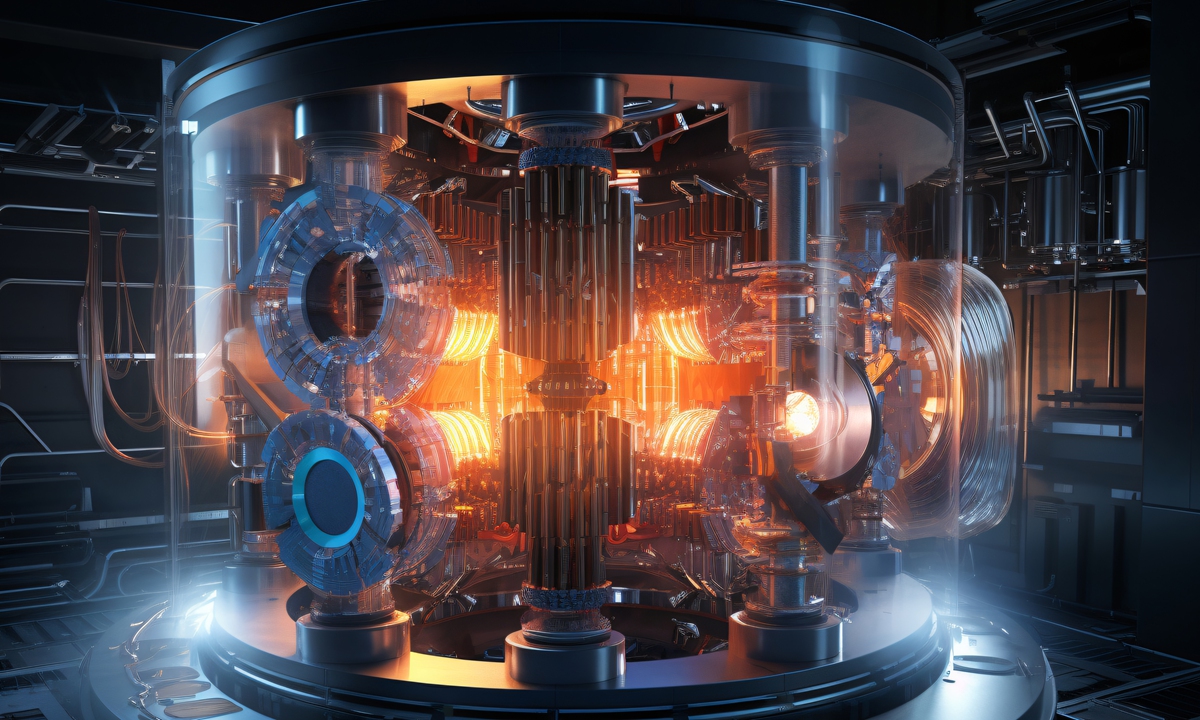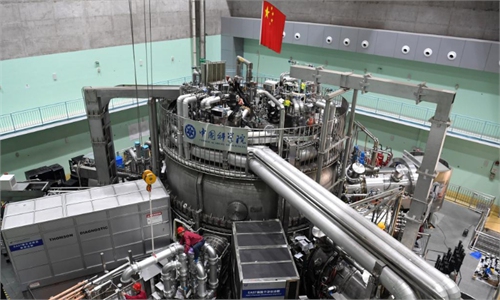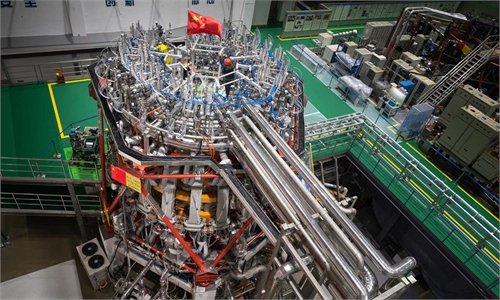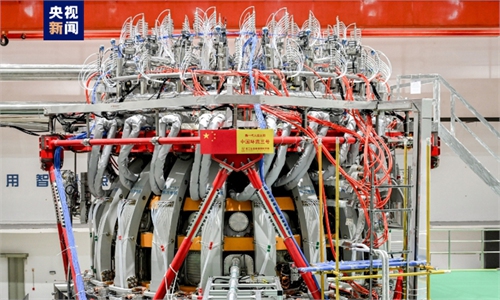IN-DEPTH / IN-DEPTH
International cooperation boosts China's competitiveness in controlled nuclear fusion: political advisor
China is playing an increasingly important role in the International Thermonuclear Experimental Reactor (ITER) project and it is due to the long-term attention and support of the country's industry and government to controlled nuclear fusion research, Duan Xuru, a senior expert on fusion who is also a member of the National Committee of the Chinese People's Political Consultative Conference, told the Global Times.

Especially through participation in the ITER project, the world's largest "artificial sun," the level of China's research in controlled nuclear fusion has been greatly improved, and the technological level has caught up and even surpassed those of other countries in some areas, said Duan, chief expert on fusion of the China National Nuclear Corp (CNNC).
The ITER is a tokamak that can generate large-scale nuclear fusion reactions, aiming to simulate the nuclear fusion process that generates light and heat like the sun. The experiment is jointly implemented by China, the European Union, India, Japan, South Korea, Russia and the US. China officially joined the plan in 2006. Since the implementation of the plan, China has always adhered to international commitments and contributed Chinese wisdom and strength to the smooth progress of the plan.
On February 29, the ITER organization signed a contract for assembling the vacuum chamber module with China Nuclear Power Engineering Co, Ltd of CNNC. This is the second time that China has undertaken the installation task of the ITER's core equipment, contributing wisdom and strength to the progress of this project, according to the CNNC.
The assembly of the vacuum chamber module is to integrate and assemble the main large components such as the toroidal field coils, vacuum chamber, and vacuum chamber thermal shield in the assembly hall, and then lift the whole assembly into the tokamak pit. Among them, the toroidal field coils provide a toroidal strong magnetic field for confining the plasma at temperatures of over a hundred million degrees, according to Duan.
Located in the central area of the device, the vacuum chamber supports the plasma confined by the magnetic field, providing the required high-purity environment for plasma formation and maintenance. The vacuum chamber thermal shield mainly provides thermal shielding for the superconducting magnets to ensure the stable operation of the low-temperature superconducting magnets. "The assembly of the vacuum chamber module is an important milestone for the ITER project, marking that the installation of the ITER main machine has entered the final sprint stage," Duan said.
China has undertaken the manufacturing tasks of 18 procurement packages of the ITER since 2008, involving core key components such as the magnet support system, magnet feeder system, power system, glow discharge cleaning system, gas injection system, and the first wall of the reactor core that can withstand extremely high temperatures.
"China's tokamak engineering construction and related physical experiments have entered the international forefront. The engineering technology and manufacturing processes of key components of fusion reactors have made key breakthroughs, and some technological levels are leading internationally. A group of enterprises, research institutions, and universities have cultivated talents in tokamak engineering construction, fusion reactor component manufacturing, and large-scale scientific project management, accumulating experience. China's international discourse power in the field of nuclear fusion research is increasing. In the fields of material production and large equipment manufacturing, China has gradually formed advantages in foreign countries, and these advantages will provide strong technical support for the high-level development of China's controlled fusion engineering technology," Duan said.
While participating in the development of ITER, China's independently constructed and operated new generation artificial sun China Circulation-3 has also continued to improve. In 2023, the device successfully achieved high-constraint operation mode under a plasma current of 1 million amperes and was opened to global scientists.
Asking about different roles of ITER and China Circulation-3, Duan explained that ITER is an experimental reactor, and its goal is to verify the scientific and engineering feasibility of fusion reactors under conditions where the fusion gain Q is greater than 10 within 400 seconds and greater than 5 within 3,000 seconds.
Meanwhile, China Circulation III is the largest and most powerful magnetic confinement nuclear fusion large scientific experimental device in China, aiming to provide preliminary verification and solutions for key scientific and technical issues of the experimental reactor, including core plasma operation, nuclear diagnostics, tritium engineering technology, divertor high heat load control, etc, serving as an important support for China's leapfrog development in fusion energy research and development, he said.
In the future, China Circulation III will strive for higher plasma operating parameters, gradually raise the comprehensive parameters of the fusion plasma core to the level of the core, create an internationally leading combustion plasma large scientific experimental platform, support China's deep participation in ITER experiments, better digest and absorb ITER research results, and lay the foundation for China's independent design, construction, and operation of fusion pilot engineering experimental reactors, Duan noted.
In Duan's view, climate change and energy security issues have become common challenges faced by the world. Considering this, nuclear fusion energy, as a future clean, safe, and efficient energy source, is of great significance for the sustainable development of human society.
Mastering the technology of controlled nuclear fusion means that people may have access to almost unlimited clean energy in the future, and the energy crisis may be completely resolved, Duan said.
But to realize the application of nuclear fusion energy, there are still some major scientific and technological challenges, mainly including the steady-state self-sustaining burning of deuterium-tritium fusion plasma, fusion reactor materials, and tritium self-sustaining, Duan said, stressing the importance of international cooperation to promote the innovation of nuclear fusion technology.

Tokamak Photo: VCG
Especially through participation in the ITER project, the world's largest "artificial sun," the level of China's research in controlled nuclear fusion has been greatly improved, and the technological level has caught up and even surpassed those of other countries in some areas, said Duan, chief expert on fusion of the China National Nuclear Corp (CNNC).
The ITER is a tokamak that can generate large-scale nuclear fusion reactions, aiming to simulate the nuclear fusion process that generates light and heat like the sun. The experiment is jointly implemented by China, the European Union, India, Japan, South Korea, Russia and the US. China officially joined the plan in 2006. Since the implementation of the plan, China has always adhered to international commitments and contributed Chinese wisdom and strength to the smooth progress of the plan.
On February 29, the ITER organization signed a contract for assembling the vacuum chamber module with China Nuclear Power Engineering Co, Ltd of CNNC. This is the second time that China has undertaken the installation task of the ITER's core equipment, contributing wisdom and strength to the progress of this project, according to the CNNC.
The assembly of the vacuum chamber module is to integrate and assemble the main large components such as the toroidal field coils, vacuum chamber, and vacuum chamber thermal shield in the assembly hall, and then lift the whole assembly into the tokamak pit. Among them, the toroidal field coils provide a toroidal strong magnetic field for confining the plasma at temperatures of over a hundred million degrees, according to Duan.
Located in the central area of the device, the vacuum chamber supports the plasma confined by the magnetic field, providing the required high-purity environment for plasma formation and maintenance. The vacuum chamber thermal shield mainly provides thermal shielding for the superconducting magnets to ensure the stable operation of the low-temperature superconducting magnets. "The assembly of the vacuum chamber module is an important milestone for the ITER project, marking that the installation of the ITER main machine has entered the final sprint stage," Duan said.
China has undertaken the manufacturing tasks of 18 procurement packages of the ITER since 2008, involving core key components such as the magnet support system, magnet feeder system, power system, glow discharge cleaning system, gas injection system, and the first wall of the reactor core that can withstand extremely high temperatures.
"China's tokamak engineering construction and related physical experiments have entered the international forefront. The engineering technology and manufacturing processes of key components of fusion reactors have made key breakthroughs, and some technological levels are leading internationally. A group of enterprises, research institutions, and universities have cultivated talents in tokamak engineering construction, fusion reactor component manufacturing, and large-scale scientific project management, accumulating experience. China's international discourse power in the field of nuclear fusion research is increasing. In the fields of material production and large equipment manufacturing, China has gradually formed advantages in foreign countries, and these advantages will provide strong technical support for the high-level development of China's controlled fusion engineering technology," Duan said.
While participating in the development of ITER, China's independently constructed and operated new generation artificial sun China Circulation-3 has also continued to improve. In 2023, the device successfully achieved high-constraint operation mode under a plasma current of 1 million amperes and was opened to global scientists.
Asking about different roles of ITER and China Circulation-3, Duan explained that ITER is an experimental reactor, and its goal is to verify the scientific and engineering feasibility of fusion reactors under conditions where the fusion gain Q is greater than 10 within 400 seconds and greater than 5 within 3,000 seconds.
Meanwhile, China Circulation III is the largest and most powerful magnetic confinement nuclear fusion large scientific experimental device in China, aiming to provide preliminary verification and solutions for key scientific and technical issues of the experimental reactor, including core plasma operation, nuclear diagnostics, tritium engineering technology, divertor high heat load control, etc, serving as an important support for China's leapfrog development in fusion energy research and development, he said.
In the future, China Circulation III will strive for higher plasma operating parameters, gradually raise the comprehensive parameters of the fusion plasma core to the level of the core, create an internationally leading combustion plasma large scientific experimental platform, support China's deep participation in ITER experiments, better digest and absorb ITER research results, and lay the foundation for China's independent design, construction, and operation of fusion pilot engineering experimental reactors, Duan noted.
In Duan's view, climate change and energy security issues have become common challenges faced by the world. Considering this, nuclear fusion energy, as a future clean, safe, and efficient energy source, is of great significance for the sustainable development of human society.
Mastering the technology of controlled nuclear fusion means that people may have access to almost unlimited clean energy in the future, and the energy crisis may be completely resolved, Duan said.
But to realize the application of nuclear fusion energy, there are still some major scientific and technological challenges, mainly including the steady-state self-sustaining burning of deuterium-tritium fusion plasma, fusion reactor materials, and tritium self-sustaining, Duan said, stressing the importance of international cooperation to promote the innovation of nuclear fusion technology.



